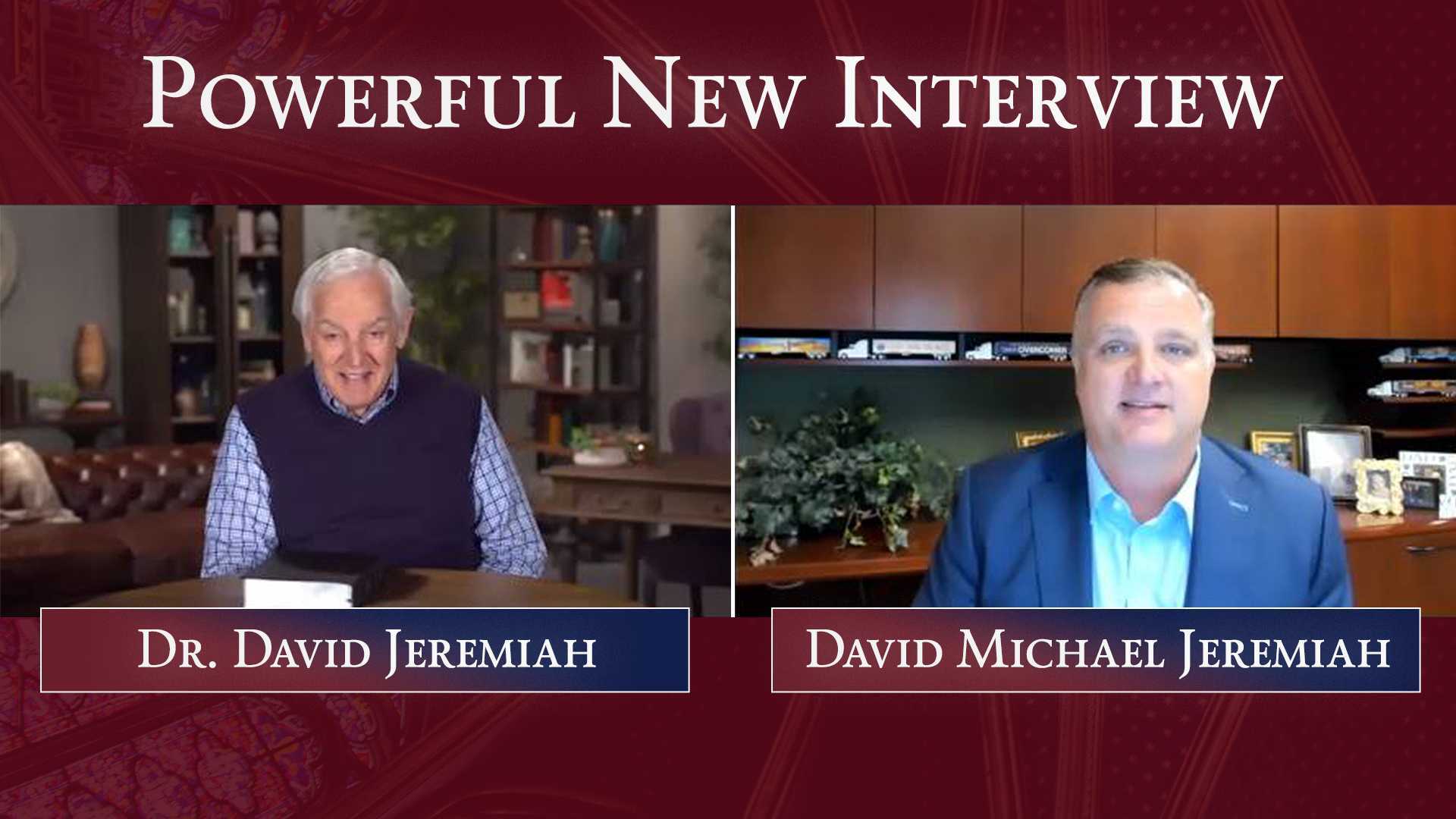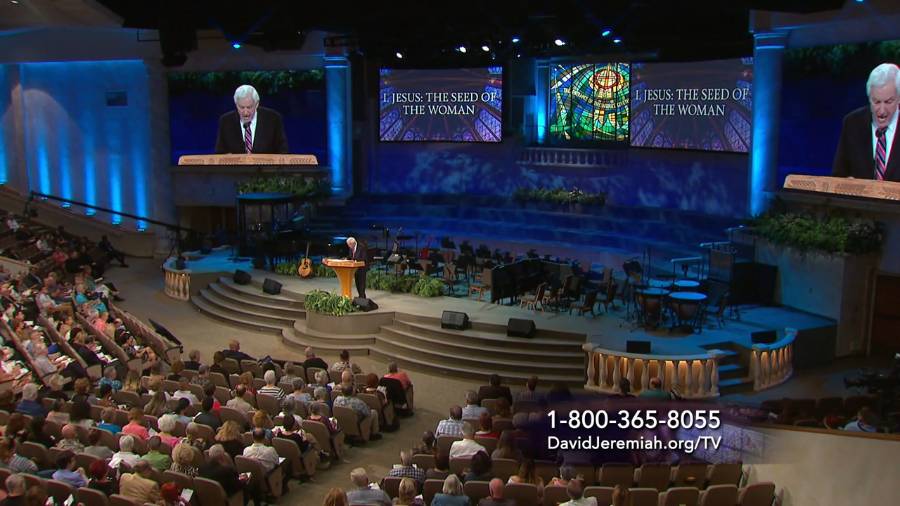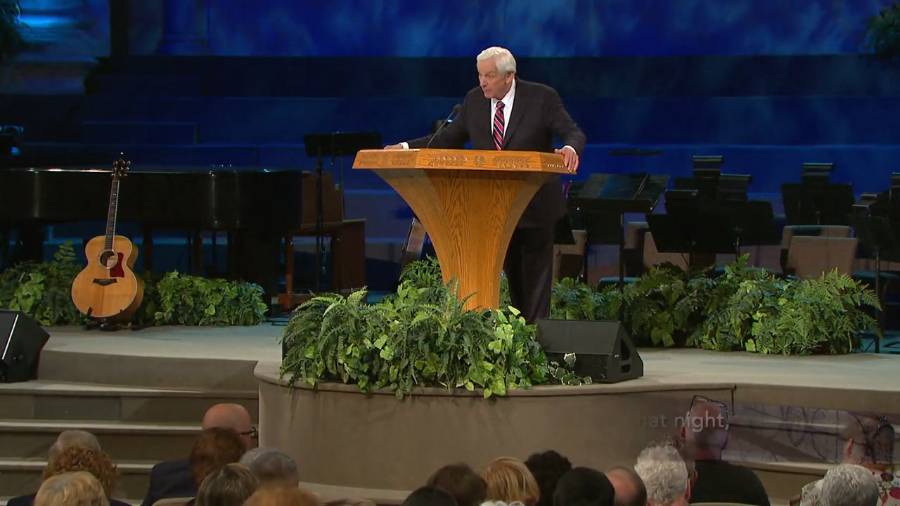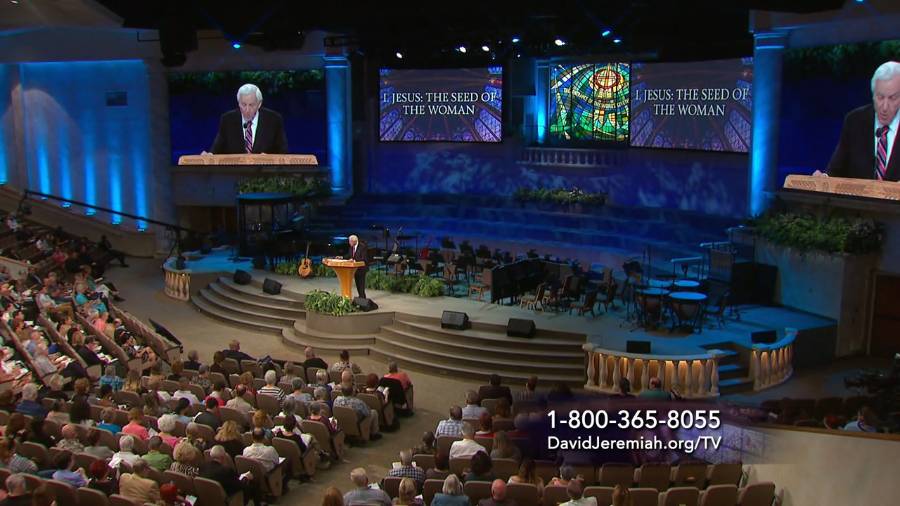The Jesus You May Not Know
Learn toFathomJesus like never before
Resources from David Jeremiah to aid in your journey from knowing about Jesus to knowing Jesus.
Is He From the Old Testament or the New Testament?
Interview with David Jeremiah
A Turning Point Exclusive
In his new book, Dr. David Jeremiah invites you to walk more closely with Jesus while opening his heart with detailed information about the dearest Person in his life. Now you can learn more about the book and his new teaching series through this conversation with another dear person in his life—his son and Turning Point COO, David Michael Jeremiah.
Thanks for downloading your free resource!
Thanks for downloading your free resource!
Is He From the Old Testament or the New Testament?
Study Guide
Selected Scriptures
In this lesson, we learn that every aspect of our Lord’s life, ministry, death, resurrection, and mission was predicted in advance throughout the books of the Old Testament.
Outline
When Dr. David Murray was asked to teach Hebrew and Old Testament in a seminary, he asked himself, “Why would God have given us the majority of the Bible in the Old Testament?” The key came when Murray realized Jesus Christ answered that question Himself. He told His disciples the Old Testament was all about Him.1 Murray learned what we’ll discover in this lesson—
Jesus is on every page of the Hebrew Scriptures,
from Genesis to Malachi.
I. Jesus: The Seed of the Woman
II. Jesus: The Passover Lamb
III. Jesus: The Bronze Serpent
IV. Jesus: The Forsaken Savior
V. Jesus: The Suffering Servant
Conclusion:
Knowing Jesus From the Old Testament Reassures Our Faith
Knowing Jesus From the Old Testament Revives Our Hearts
Knowing Jesus From the Old Testament Restores Our Hope
Overview
When His critics challenged His identity as recorded in John’s Gospel, Jesus replied, “And the Father Himself, who sent Me, has testified of Me. You have neither heard His voice at any time, nor seen His form. But you do not have His word abiding in you, because whom He sent, Him you do not believe. You search the Scriptures, for in them you think you have eternal life; and these are they which testify of Me. But you are not willing to come to Me that you may have life” (John 5:37–40).
The word “Scriptures” here referred to the Old Testament, for the New Testament hadn’t yet been given. Jesus was claiming that God the Father spoke of Him in the inspired pages of the Old Testament. As we study this subject in the Old Testament,
we can pinpoint more than three hundred specific predictions about Christ,
plus a multitude of signs, types, indications, and foreshadowings—all pointing to Him. His birth, His life, His character, His ministry, His betrayal, His death, His resurrection, and His ascension were detailed hundreds of years before they occurred.
When you read the Old Testament with Jesus in mind, everything is different. It’s impossible to miss it. We realize the Hebrew Scriptures are more than a collection of stories; they present the portrait of the coming Messiah.
In this lesson, we don’t have time for an exhaustive study of Old Testament Messianic prophecy, but we can touch on five great examples.
Jesus: The Seed of the Woman
The first presentation of the Gospel in the Bible occurred as early as the Garden of Eden. We find it in the third chapter of the book of Genesis—in Genesis 3:15. Theologians call this verse the protoevangelium. Proto means “first” and evangelium means “gospel.” They call Genesis 3:15 the “first Gospel.”
The Bible begins with the book of Genesis and its story of Creation when God spoke and the universe came into existence. He created Adam and Eve for fellowship with Himself, but they violated His command and disobeyed Him. It was a sad day for all humanity as we fell into sin. When the first couple disobeyed the commandment of God, which was given in the abundance of His blessing, God punished them. But He never gave up on them. The Lord had already prepared a plan of redemption to take care of Adam and Eve, and to ultimately take care of us.
Genesis 3:15 is the record of what God said to Satan. It’s incredible that the first promise of the coming Redeemer was spoken by God to Satan. Almighty God said in Genesis 3:15: “And I will put enmity between you and the woman, and between your seed and her Seed; He shall bruise your head, and you shall bruise His heel.”
That sounds like a code, and in a sense it is. God told Satan that one day the Seed of the woman—Jesus—would come. He predicted that Satan would bruise the Messiah’s heel, but the Messiah would crush Satan’s head. In other words, there would be a tremendous conflict between Satan and the promised Seed of the woman. The latter would be hurt, but the former would be destroyed. Romans 16:20 says, “And the God of peace will crush Satan under your feet shortly.”
When Jesus went to the cross, Satan bruised His heel. Satan thought he had won, but he didn’t destroy Jesus; he just bruised His heel. The Bible says one day Jesus will come again and crush Satan’s head.
With that thought in mind, read Galatians 4:4–5 which says, “But when the fullness of the time had come, God sent forth His Son, born of a woman, born under the law, to redeem those who were under the law, that we might receive the adoption as sons.”
Genesis 3:15 is one of the most encouraging verses in the Bible, because it is the first promise of the Gospel.
Here we get the first inkling that a Savior would come into the world to defeat Satan and bring us back to the family of God.
Jesus: The Passover Lamb
Turning to the book of Exodus, we see another picture of the coming Savior—the Passover Lamb. God’s plan of redemption continues to unfold, and here we have one of the Bible’s greatest types.
The early chapters of Exodus describe the conflict between Pharaoh and Moses. God hurled many plagues against the Egyptians, culminating with the night when the Lord struck down the firstborn in every home in Egypt. But among the enslaved Hebrews, a special instruction was given. Every family was to take a spotless lamb, slaughter it, and brush its blood on the doorposts and lintels of their house.
Exodus 12:12–13 says, “For I will pass through the land of Egypt on that night, and will strike all the firstborn in the land of Egypt, both man and beast; and against all the gods of Egypt I will execute judgment: I am the Lord. Now the blood shall be a sign for you on the houses where you are. And when I see the blood, I will pass over you.”
That’s the origin of the word Passover. Jewish people celebrate the night when the angel passed over the houses where the blood was on display on the doorposts. Through this vivid Old Testament story of divine deliverance, the Lord revealed His pattern and His plan. Our salvation requires the sacrifice and blood of an innocent, spotless lamb (Jesus). That’s exactly how the ministry of Jesus was introduced 1,400 years later when John the Baptist introduced the Messiah to the world, when he said, “Behold! The Lamb of God who takes away the sin of the world!” (John 1:29)
Think of all the things John could have said. Behold the King of Israel! Behold the Messiah! Behold the King of kings! Behold the Prince of Peace! Behold Immanuel!
Peter later wrote, “You were not redeemed with corruptible things, like silver or gold, from your aimless conduct received by tradition from your fathers, but with the precious blood of Christ, as of a lamb without blemish and without spot” (1 Peter 1:18–19).
Just as the lamb in the Old Testament enabled the death angel to pass over the houses of the Israelites who displayed the blood on their doorposts, so the blood of the Lamb of God who was slain on Calvary, when applied to our hearts, keeps us from the judgment of our sin and death. Our sins are covered by the precious blood shed for us.
In the Old Testament, He is the Passover Lamb. In the New Testament, He’s the Lamb of God who takes away the sin of the world. This is arguably the most poignant description of the Person and work of the Messiah, and its truth stretches from Genesis to Revelation.
Jesus: The Bronze Serpent
The book of Numbers describes one of the most vivid symbols of Christ in the Old Testament—the bronze serpent. In Numbers 21, the children of Israel grew impatient and sinned recklessly, and grumbled against Moses and against God. As discipline, the Lord sent venomous snakes among them. The people cried out to Moses, confessing their sin and begging for mercy from God. Moses prayed for the people that God would take this punishment away. The Lord spoke to Moses and told him, “Make a fiery serpent, and set it on a pole; and it shall be that everyone who is bitten, when he looks at it, shall live” (Numbers 21:8). The Bible says, “So Moses made a bronze serpent, and put it on a pole; and so it was, if a serpent had bitten anyone, when he looked at the bronze serpent, he lived” (verse 9).
Over a thousand years later, a man named Nicodemus sought out a young rabbi named Jesus of Nazareth for personal counseling. Jesus reached back into the book of Numbers and claimed that the bronze serpent was a biblical preview of His own work on the cross. He said, “And as Moses lifted up the serpent in the wilderness, even so must the Son of Man be lifted up, that whoever believes in Him should not perish but have eternal life” (John 3:14–15).
People in the wilderness looked to the serpent and they were healed. And when you and I look to Jesus, so are we. The remedy for our past sinful choices isn’t to heal ourselves. The remedy is to simply look to Jesus. Look to the cross and say, “I know You’re there for me. You paid the penalty for my sin.” It’s the perfect illustration of Jesus, and it is found in Numbers chapter 21. That is Jesus in the Old Testament.
Jesus: The Forsaken Savior
Let’s move out of the historical books of the Old Testament and open the book of Psalms. We can discover a lot about the Lord Jesus Christ in the 150 chapters of this great book of the Bible, for many of the Psalms are Messianic in nature and have specific predictions about the coming Messiah. But we only have time in this lesson to pause at Psalm 22, which foretells the crucifixion and resurrection of Christ so accurately you would think the writer was standing at the foot of the cross. Psalm 22 predicts the words Jesus utters while dying on the cross (verse 1); the public nature of His suffering and death (verse 7); the exact words flung at Him by bystanders (verse 8); the dehydration and loss of bodily fluids involved in His death (verse 14); the disjointed position of His body (verse 14); His intense thirst (verse 15); the piercing of His hands and feet (verse 16); His unclothed state in death (verse 17); the gambling away of His garments by the executioners (verse 18); His declaration of victory at the resurrection (verse 22); and the global impact of the message of death and resurrection throughout history (verses 27–31).
All that, one thousand years in advance!—though the process of execution by crucifixion was not even invented at that time.
Yet David vividly described it in this Psalm that was written ten centuries before it actually happened.
Jesus: The Suffering Servant
Now let’s move to the prophet Isaiah, whose book contains so much prophetic information about the coming Messiah we sometimes call the book of Isaiah the “Fifth Gospel.” According to this prophet, the Messiah would be born of a virgin (Isaiah 7:14); He would be called Immanuel, which means, “God with us” (7:14); He would come from Galilee (9:1); He would be born a Child, a Son; the Prince of Peace who would inherit the throne of His father David (9:6–7); He would be anointed by the Holy Spirit (11:1–2); He would possess remarkable traits of character and personality (11:3–5); and do something so extraordinary on a mountain that the shroud of death covering all nations would be destroyed and He would swallow up death forever (25:6–8).
Isaiah wrote all about Jesus approximately seven hundred years before the Savior was born.
When you come to the great fifty–third chapter of Isaiah, you have the story of the Suffering Servant. Isaiah wrote: “But He was wounded for our transgressions, He was bruised for our iniquities; the chastisement for our peace was upon Him, and by His stripes we are healed. All we like sheep have gone astray; we have turned, every one, to his own way; and the Lord has laid on Him the iniquity of us all” (Isaiah 53:5–6).
These examples are only a portion of the Old Testament prophecies related to Jesus Christ. Mathematicians who have studied the prophecies about Christ in the Old Testament have concluded that the probability of all the predictions about Him coming true is virtually nonexistent without the hand of an omniscient God recording in advance what would happen. Jesus Christ is the promised Messiah, and there isn’t any question about it. Any honest and reasonable person who studies this subject with integrity and an open mind can only be amazed at the accuracy of the fulfillments.
To know the Suffering Servant of Isaiah is to know the Gospel and the extraordinary love of Jesus!
Conclusion
What, then, does this mean to us?
Knowing Jesus From the Old Testament Reassures Our Faith
First, when we study the fulfilled Old Testament prophecies about Christ, it tremendously strengthens our faith. Some people believe that faith is believing in something despite the evidence, but it’s actually believing in something because of the evidence. The Bible tells us the truth. Whenever we have a trickle of doubt about the truthfulness of Christianity, one of the best things we can do is go back and read Psalm 22 or Isaiah 53 or spend some time in a survey or summary of Old Testament Messianic prophecy. Our faith is always reassured and affirmed, for no one except God could have made so many predictions—all of which came true exactly as stated.
Knowing Jesus From the Old Testament Revives Our Hearts
Second, knowing Jesus from the Old Testament brings revival to us; it makes our heart burn. In Luke 24, two disciples were walking to the village of Emmaus on Easter Sunday, and they were troubled and confused. All of a sudden, Someone caught up with them and began walking with them. It was Jesus, but they did not recognize Him. They told Him of their hopes that Jesus would be the One to release them from their bondage. When they arrived at their home, they offered Him dinner, and as He broke the bread, they realized Who it was who had been with them.
Luke 24:32 says, “And they said to one another, &lsqou;Did not our heart burn within us while He talked with us on the road, and while He opened the Scriptures to us?’” When Jesus opened the Old Testament Scriptures concerning Himself, their hearts revived, and they were filled with joy and excitement at this truth: The Jesus of the Old Testament is the Jesus of the New Testament. He is the promised Messiah.
Knowing Jesus From the Old Testament Restores Our Hope
And then, knowing the truth about Messianic prophecy and that Jesus fulfills that calling restores our hope. Writing about the purpose of the Old Testament, the apostle Paul said: “For whatever things were written before were written for our learning, that we through the patience and comfort of the Scriptures might have hope” (Romans 15:4). We have hope. It’s not hope–so hope, it’s a know so hope. We know that Jesus is who He claims to be.
Make sure the promised Messiah is your Savior, study His portrait, and always remember the combination to a life of joy and victory is the simplest formula in the world—it’s simply J–E–S–U–S. He is the Jesus of the Old and the Jesus of the New Testaments. We find Him in the Old in prophecy and picture; we find Him in the New in presence and in power.
Most of all, we must find Him in our heart. He built a space within us only He can fill. We can try to fill it with everything else, but only Jesus satisfies us. It’s not a matter of simply knowing about Him; it’s a matter of knowing Him, loving Him, and walking with Him in the everyday experience of life. We were created for Him—the Jesus of the Old and New Testaments, the Jesus of eternity.
Personal Questions
Read John 5:31–40.
-
Jesus answered His critics by saying He had three sources of testimony—John the Baptist (verses 33–35); His own works and miracles (verse 36); and God the Father through the pages of the Old Testament Scriptures (verses 35–39). When the New Testament uses the word “Scriptures,” to what does it refer?
What do you think Jesus meant when He said the Scriptures testify of Him?
In what way did the critics of our Lord fail? (verse 40)
-
If we respond correctly to the three–fold witness of Christ, what gift do we receive? (verse 40)
Read Genesis 3:14–15.
To whom are these statements addressed?
How would you explain the last part of verse 15?
Read 1 Peter 1:18–21.
How are we redeemed?
When did God decide to redeem the world in this way? (verse 20)
Read Psalm 22:16–31.
What words indicate the great change of tone between verses 21 and 22?
In what way is this predictive of the resurrection of Jesus Christ?
In verse 27, who will benefit from this message?
In verse 31, who else will benefit?
Group Questions
-
Read Genesis 3:15.
How would you paraphrase this verse to highlight the Messianic nature of what God was saying to Satan?
In what way was Jesus’ heel bruised? Do you think this is to be taken literally?
What is the significance of Satan’s head being crushed? Is this a past or future event?
-
Take some time to trace the doctrine of the Lamb through the passages below. Discuss with the group how they speak to you—spiritually, emotionally, and intellectually?
Genesis 4:4; 22:7
Exodus 12:5
Leviticus 23:12
Isaiah 53:7
John 1:29
Acts 8:32
1 Peter 1:19
Revelation 21:23
What should the fulfillment of these and other Messianic Scriptures tell us? See Luke 24:32–45.
How this is personally encouraging to you? Share your answer with the group.
Discuss in what way fulfilled Messianic Scripture is evidence of and a defense for the integrity of the Christian faith?
If the prophecies of our Lord’s first coming were fulfilled so completely, how should we treat the predictions about His Second Coming?
Read Isaiah 53 and list five predictions that were fulfilled by Jesus when He came. Share with the group what verse in this chapter is the most compelling to you?
Did You Know?
In his book Science Speaks, mathematician Peter Stoner applied the mathematical principles of probability to various Old Testament predictions. Stoner selected eight Old Testament predictions relating to Christ’s life and ministry and formulated the mathematical probability of their coming true in one man. The probability was equivalent to covering the state of Texas with silver dollars to a depth of two feet, then marking one of those silver dollars and dropping it somewhere into the pile, stirring it thoroughly. The chance of a blindfolded man choosing the marked silver dollar is equal to the chances of all eight of those prophecies being fulfilled in one man in history. Yet there are not eight but more than three hundred predictions.2
1David Murray, Jesus on Every Page (Nashville, TN: Thomas Nelson, 2013), 10–18.
2Peter Stoner and Robert Newman, Science Speaks (Chicago: Moody Press, 1958).
This content is an excerpt from The Jesus You May Not Know study guide.
You Might Also Enjoy…
Thanks for downloading your free resource!
Thanks for downloading your free resource!


























